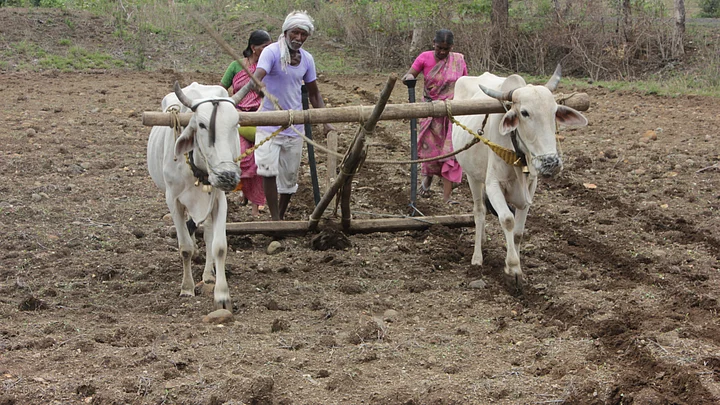An Indigenous Tale of Cotton
A visit to Vidarbha on a shoot for a half-hour episode on cotton as part of a television series on ‘smart agriculture’ turns out to be quite educative. Keshav R Kranthi, director of the Central Institute of Cotton Research in Nagpur, says that India is home to all four varieties of cotton, but where the British failed, the market has succeeded; American cotton has pushed the hardy desi to the fringe – it occupies less than 1% of cotton acreage from 97% at the time of Independence.
Hybrids Galore
Another nugget is that alone among the world’s 80 cotton producers, India has opted for hybrids; the world’s first was introduced in 1971.
But their coverage has expanded from 40% in 2002 to more than 90% now on the strength of a protective gene with insecticidal properties derived from the Bt soil bacterium. Again, the gene was incorporated into hybrids with an American multinational’s technology.
Mahatma’s Home Vidharba Makes Cotton Political Issue
We find a range of political statements being made through the act of growing cotton. This is after all Vidarbha where Mahatma Gandhi set up Sevashram (in Wardha) as his adopted home after the Dandi march and the salt satyagraha. This is where Bhim Rao Ambedkar renounced the religion he was born into and embraced Buddhism. It is also the headquarters of black-capped and fat-calved Hindu nationalists.
A Few Encounters
We meet Narendra Misal, aka Balasaheb, 49, in Amgaon. He practices agriculture uncontaminated by Bt technology and chemical fertiliser. A post-graduate in Commerce and Philosophy from Nagpur University, he is chairman of the district’s 400-member Sarvodaya Mandal, whcih was formed after Gandhi’s death and backed by Vinobha Bhave. Misal is not a yield chaser. What matters to him is what’s left on the table. He admits, “90% of the people are not with us,” because “influenced by media and advertising” they do not understand the difference.
About a 100 kms way in Yavatmal district’s Hivree village we meet Vijay Mahadev Niwal, 52, a graduate in engineering from Mumbai’s Victoria Technical Institute. He is a large farmer with 75 acres and has a larger appetite for trying out new things. Niwal is a member of the Shetkari Sanghatana because he agrees with founder Sharad Joshi’s philosophy of “freedom of the markets, freedom (in choice) of technology and minimum power of government.”
He boasts that he distributed a large quantity of pirated Bt cotton seeds from Gujarat a year before the government approved them in 2002. He justifies the illegality as motivated by a concern for fellow farmers who were driven to rack and ruin by pink, green and spotted bollworms. He says they had little patience with Delhi’s long-winded regulatory process and the politics that was holding up approval of Bt hybrids.
Back in Wardha we meet Atul Sharma who is the dean for agricultural outreach at Shiksha Mandal, a trust set up by Gandhi’s industrialist patron, Jamnalal Bajaj, and his host in Wardha before Sevashram was established. Sharma asserts that farmers should have “seed sovereignty” or the right to own and use seed rather than be obliged to buy it from the market. The time has come, he says, for farmers to be saved from the seed companies.
The Science of Cotton
Shiksha Mandal has been roped in by the cotton research institute to propagate high density planting of straight cotton varieties in dryland areas of central India. The science is straight forward. Cotton plants require the most water when green bolls are formed. Borer worms get attracted by the scent of bolls. If boll formation is advanced to the monsoon season through early sowing, the crop will not suffer when the rains withdraw. It can also escape the infestation of bollworms as they avoid the monsoons so their eggs do not get washed away.
In high density cultivation, a plant is expected to put out four to eight bolls before it dies. So plant protection becomes easy. When 40 to 80 bolls are expected, as with hybrids, the flowering is staggered and pests gets a longer playing time.
The “Chakravyuh” of Private Bt Technology
CICR says it is persuaded by economics and science, but one can discern a battle for turf. Kranthi says the public sector had 60 to 70 percent of the market before Bt hybrids came on the scene. Vijay Jhawandia, a founder member of the Shetkari Sanghatana who quit in 1993 over its advocacy of free enterprise, asserts that the public sector must act as Krishna and liberate the farmer Abhimanyu from the chakravyuh-trap of private Bt technology.
Kranthi advocates high density planting of 44,000 plants per acre, which is viable only if the seed is free or very cheap; not at rates charged by private seed companies.
But there have been few takers for high density planting. Farmers cannot erase memories of bollworm terror before Bt hybrids came into the picture and will not risk planting straight varieties that do not have the protective gene.
Unfortunately, the public sector, including CICR, has been unable to win regulatory approval for their own Bt technology despite several attempts. That is, until now. On July 15, a team of scientists led by geneticist and former vice chancellor of Delhi University Deepak Pental transferred the Bt cotton technology they had developed to CICR and (earlier in April) to Punjab Agricultural University.
It will take three or four years before the gene is spliced into their varieties and hybrids in field conditions, bio-safety is established and regulatory approval obtained. Kranthi says high density planting would have got off to a winning start if he had Bt technology. High density planting might yet take off with a technology popularised by the Americans.
(Vivian Fernandes is consulting editor at www.smartindianagriculture.in)
(At The Quint, we question everything. Play an active role in shaping our journalism by becoming a member today.)
